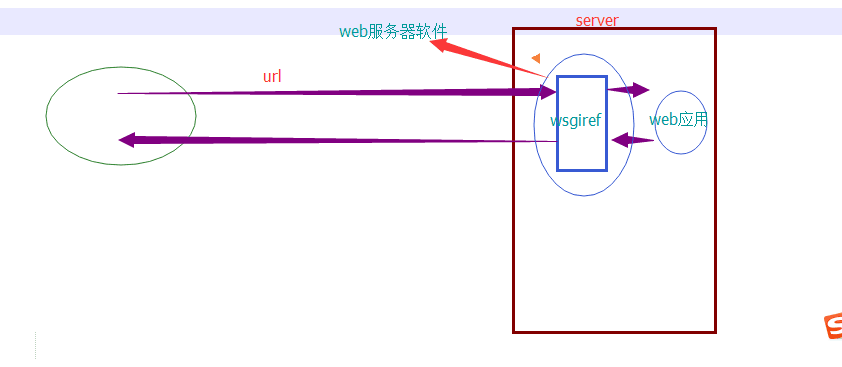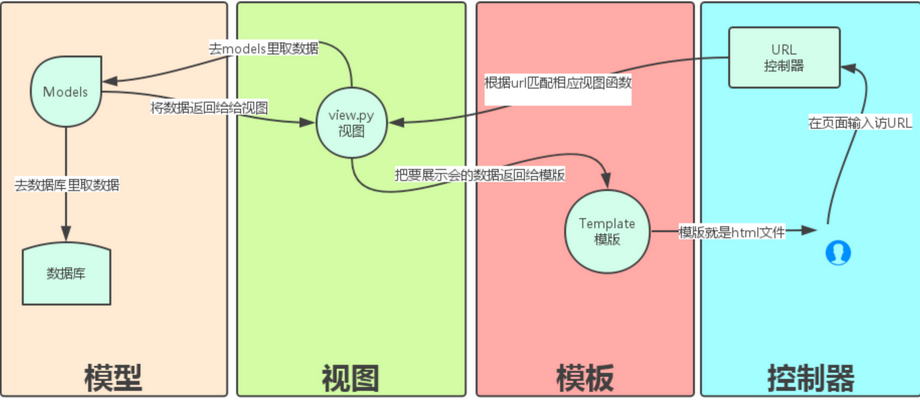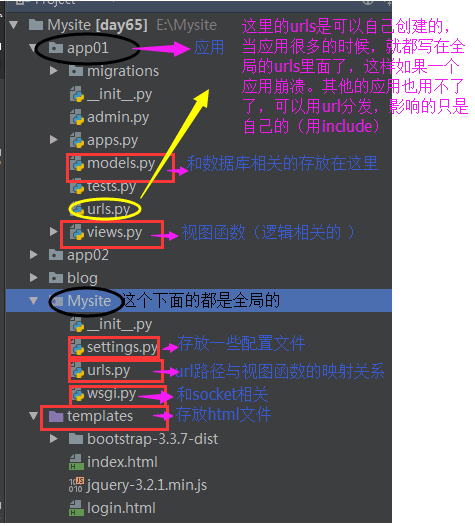A small problem:
What is the root directory: that there is no path, only the domain name. url (r '^ $')
Supplementary wsgiref module on a map

MTV model
Django's MTV represent:
Model (model): database and related business objects and object is responsible for the database (ORM)
Template (template): put all the html file
template syntax: The aim is the independent variable (the content of the database) how cleverly embedded in html page
View (View): is responsible for the business logic, and calls the Model and Template at the appropriate time
In addition, Django there is a URL dispatcher. His role is to be a one page URL requests are sent to different treatment of Views, Views and then call response Model
And Template.


Django basic commands
1. Download Django:
pip3 install django
2. Create a Django objects
django- admin.py startproject project name
Django -admin.py startproject mysite
After you create the success of such a project will generate. Directory structure is as follows:

-
manage.py -------- startup file (Django project inside the tool by which you can call the number Django shell and databases)
-
settings.py ----------- contains some set of projects, including database information, mode flags, and other variables to work.
-
urls.py -------------- mapping between the path and the view function
3. Create an application
python3 manage, py startapp blog (application name)
After you create the success of such a project will generate. Directory structure is as follows:

4. Start Django project
python3 manage.py runserver 8080
So that our django started up when we visit:! Http: //127.0.0.1: 8080 / when you can see:

5. Create Table command
python3 manage.py makemigrations
python3 manage.py migrate
The routing configuration view layer system (views)
URL configuration (URLconf) as the Django directory site support. His nature is a mapping table between the URL and the URL you want to call that view function;
You're in such a way to tell Django, call the code for this URL, call that code for that URL.
'' ' The urlpatterns = [ URL (regex, views view function, parameter, alias) ] Parameters: a regular expression string a callable, usually a string path view function is designated as a view or function the optional parameters to be passed to the default view function (a dictionary) an optional parameter name '' '
Parameters of the string that URLconf
1. Simple Configuration
from django.conf.urls import url from . import views urlpatterns = [ url(r'^articles/2003/$', views.special_case_2003), url(r'^articles/([0-9]{4})/$', views.year_archive), url(r'^articles/([0-9]{4})/([0-9]{2})/$', views.month_archive), url(r'^articles/([0-9]{4})/([0-9]{2})/([0-9]+)/$', views.article_detail), ]
Note that:
'' ' NOTE: . 1, once the match is successful discontinued 2, to capture a value from the URL, only to place a pair of parentheses around it. 3, do not need to add a leading backslash, because each URL has. For example, it should be ^ articles, not ^ / articles. 4, the front of each regex 'r' is optional but suggested adding. Some examples request: / Articles / 2005/3 / URL does not match any pattern, because the list of the third month should be the model requires two numbers. / articles / 2003 / The first match in the list mode is not the second, because the pattern matched in sequence, the first one will be the first test match. / articles / 2005/03 / request list matches the third mode. Django would call the function views.month_archive (request, '2005', '03'). '' '
# Is set to open URL to access the item is not following the address / jump to with the / path APPEND_SLASH = True